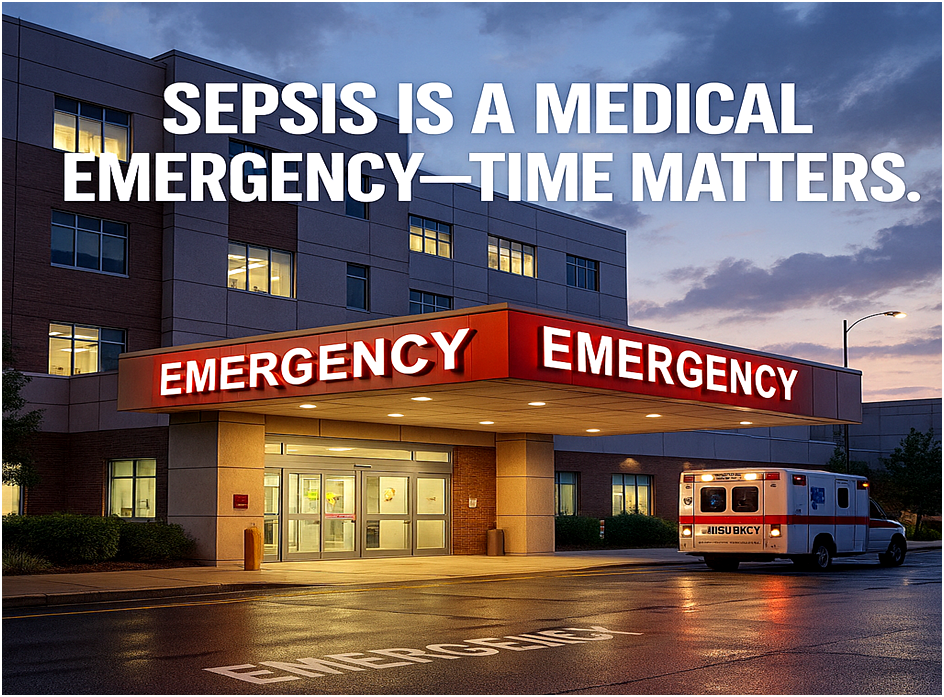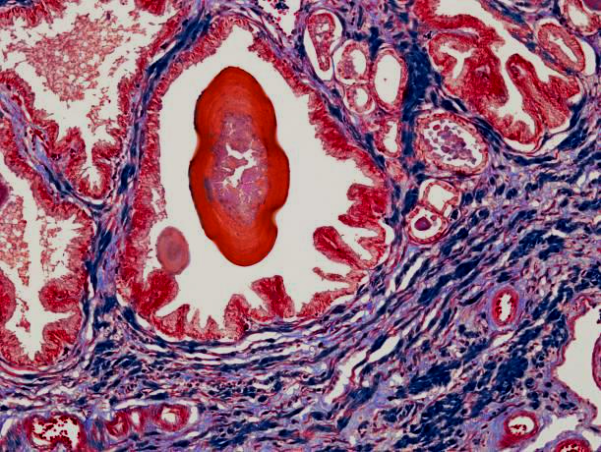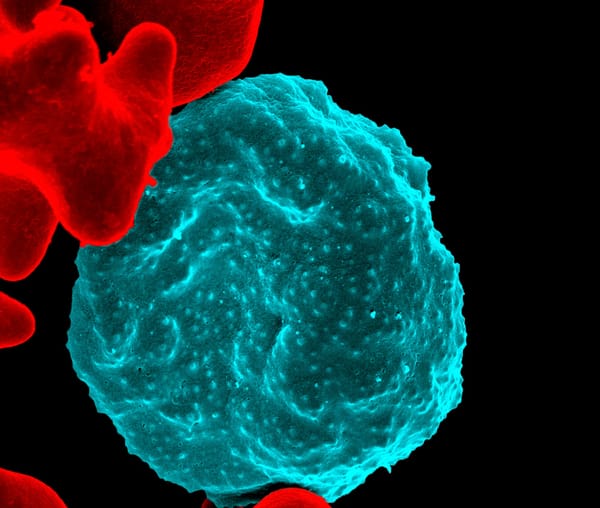Seconds Count: Why Early Action Against Sepsis Matters

Every year, millions of lives are cut short by sepsis, a condition that remains dangerously under-recognized despite its global impact. Many people have never even heard of it, yet it kills more people annually than breast cancer, HIV, and malaria combined. Sepsis occurs when the body’s natural defence system meant to fight off infection spirals out of control. Instead of targeting harmful bacteria or viruses, the immune system goes into overdrive, releasing chemicals that cause widespread inflammation.
This chain reaction leads the body to attack its own tissues and organs, often with devastating consequences. Kidneys fail, lungs struggle, and blood pressure drops, pushing the body into septic shock. Without urgent treatment, this cascade can quickly lead to multi-organ failure and death.
What makes sepsis especially deadly is the speed at which it progresses. Every hour of delayed treatment increases the risk of death by as much as 7%, meaning that even short delays can be fatal. Unlike some conditions that develop gradually, sepsis demands immediate recognition and emergency care. Time is not just money, it is life.
What Is Sepsis?
Sepsis is not an infection in itself; it is the body’s extreme and often deadly reaction to an existing infection. Normally, when the body detects harmful bacteria, viruses, or fungi, the immune system responds by releasing chemicals to fight the infection and protect vital organs. However, in the case of sepsis, this protective response spirals out of control. Instead of containing the infection, the body launches a widespread attack on itself, causing inflammation that spreads through the bloodstream. This chain reaction can quickly overwhelm the body, damaging tissues, shutting down organs, and in severe cases, leading to death.
What makes sepsis particularly dangerous is that it can arise from almost any type of infection. Some of the most common culprits include pneumonia, which affects the lungs; urinary tract infections that spread to the kidneys; abdominal infections, such as appendicitis or peritonitis; and infections that develop in wounds or surgical sites. In each of these cases, what begins as a localized problem can escalate into a full-body emergency if not recognized and treated early.
Understanding sepsis is critical because it is both common and preventable. By knowing which infections carry the highest risk and acting quickly when symptoms appear, lives can be saved.
Sepsis in Developing Countries vs. Western Countries
In developing countries, sepsis remains alarmingly prevalent, especially in communities where healthcare access is limited and infectious diseases place an additional burden on already vulnerable populations. Conditions such as HIV and tuberculosis (TB), which are far more common in the developing world than in many Western nations, significantly increase the risk of developing sepsis. This means that infections that might be easily managed elsewhere can quickly escalate into life-threatening emergencies.
According to 2017, SciELO South Africa Journal article, in some parts of the developing world, mortality rates from sepsis can reach 30 - 40%, nearly double the fatality rates reported in many Western hospitals, where survival is higher due to earlier detection and more advanced medical support. In Western countries, sepsis mortality typically ranges from 20–30%, and in well-resourced settings, even lower when rapid-response systems are in place.
So why the difference? Several critical factors explain this gap:
- Healthcare Access
One of the biggest challenges in developing countries is delayed access to hospitals and critical care units. Many patients live far from advanced healthcare facilities, and the number of intensive care unit (ICU) beds is limited compared to Western systems. As a result, patients often arrive at hospitals in later stages of sepsis, when the condition has already progressed to severe organ damage.
- Burden of Infectious Diseases
The prevalence of HIV, TB, and untreated bacterial infections in developing countries adds another layer of complexity. These conditions weaken the immune system and increase the likelihood of infections spiralling into sepsis. Western countries, by contrast, tend to have lower rates of such underlying infectious diseases, making the population overall less susceptible to severe sepsis cases.
- Awareness Gaps
A final but crucial factor is the lack of awareness. Many people in developing countries are unfamiliar with the early warning signs of sepsis such as confusion, rapid breathing, high fever, or discoloured skin. This leads to dangerous delays in seeking medical attention. In Western nations, where public health campaigns and broader awareness initiatives are more common, people are often quicker to recognize the seriousness of symptoms and seek urgent help.
The combination of these factors like limited access, higher infectious disease burdens, and lower awareness, creates a perfect storm in developing countries, making sepsis a far deadlier threat than it is in many Western nations.
Causes and Risk Factors
Sepsis can develop from any type of infection, whether it begins in the lungs, urinary tract, abdomen, or even a small wound. However, not everyone faces the same level of risk. Certain conditions and circumstances make some individuals far more vulnerable to sepsis than others. Understanding these risk factors is essential in preventing infections from escalating into life-threatening emergencies.
One of the most significant risk factors is a weakened immune system. People living with HIV, diabetes, or cancer often have reduced ability to fight off infections effectively. Those undergoing treatments such as chemotherapy are also at greater risk because their immune defences are suppressed, making it easier for infections to spread unchecked and trigger sepsis.
Individuals with chronic illnesses are particularly vulnerable. Conditions such as heart disease, kidney disease, or liver disease strain the body’s overall health, leaving it less capable of managing infections. In these cases, even minor infections can quickly
overwhelm the body and progress to sepsis.
Another major factor is poor access to clean water and sanitation. In many communities, especially in low-resource settings, contaminated water and inadequate sanitation facilities increase the risk of repeated infections, particularly gastrointestinal ones. These infections, if left untreated or poorly managed, can lead to sepsis, especially among children and other vulnerable groups.
Sepsis can also develop following recent surgery or invasive medical procedures. Surgical wounds, catheters, or ventilators can sometimes act as entry points for harmful bacteria. If these infections are not identified and controlled early, they can spread into the bloodstream and cause sepsis.
Finally, age plays a crucial role in vulnerability. The very young and the elderly are at heightened risk. Infants and young children have developing immune systems that are not yet fully equipped to handle severe infections. Older adults, on the other hand, often have weakened immune responses and are more likely to have underlying health conditions, making them especially susceptible to sepsis.
By recognizing these causes and risk factors, families, caregivers, and healthcare providers can take proactive steps such as ensuring proper hygiene, seeking prompt medical care for infections, and monitoring high-risk patients closely—to reduce the chances of sepsis taking hold.
Symptoms You Shouldn’t Ignore
When it comes to sepsis, early recognition is absolutely critical. The sooner treatment begins, the higher the chances of survival. Unfortunately, sepsis symptoms can sometimes be mistaken for less serious illnesses, leading to dangerous delays. To help with awareness, experts often use the acronym SEPSIS to highlight the red-flag warning signs that should never be ignored.
One of the most alarming symptoms is slurred speech or confusion. This occurs when the infection and resulting inflammation begin to affect the brain and nervous system. Someone with sepsis may seem unusually drowsy, disoriented, or unable to respond clearly, which should be taken as a serious warning.
Another key sign is extreme shivering, fever, or chills. While fevers are common with many infections, the intensity in sepsis is often much higher. The body may shake uncontrollably or alternate between burning with heat and feeling icy cold. These are clear signals that the infection is overwhelming the body.
Not passing urine in a day is also a critical indicator. The kidneys are highly sensitive to sepsis, and when they begin to fail, urine output drops dramatically. This is a red flag that the body’s organs are under severe stress and urgent medical attention is needed.
Difficulty in breathing is another hallmark symptom. Severe breathlessness happens because sepsis affects the lungs and circulatory system, making it hard for oxygen to reach vital organs. If someone is struggling to catch their breath, gasping, or breathing unusually fast, it may be a sign of sepsis progressing rapidly.
Sepsis also causes a profound feeling of impending doom. Many patients describe it as “feeling like you might die”, a deep sense of severe malaise that goes beyond ordinary illness. This intuition, combined with physical symptoms, should not be dismissed.
Finally, changes in skin appearance can provide critical clues. Skin that is mottled, discoloured, or very pale suggests poor blood flow, which often happens when sepsis progresses toward septic shock. These skin changes can occur quickly and signal that circulation is failing.
Together, these symptoms form a dangerous picture of how quickly sepsis can escalate. Recognizing them early and seeking immediate medical care can mean the difference between recovery and tragedy. If you notice any combination of these signs in yourself or a loved one, treat it as an emergency and get help without delay.
Why Early Action Matters
Sepsis is a medical emergency that moves at a frightening pace. Unlike some illnesses that develop gradually over days or weeks, sepsis can escalate in just a few hours. An infection that begins in the lungs, urinary tract, or even a minor wound can suddenly trigger the body’s overwhelming response, leading to widespread organ failure. Because of this rapid progression, every moment matters.
Early detection is the most powerful tool we have in saving lives. When sepsis is recognized quickly, prompt treatment with antibiotics, intravenous fluids, and supportive care for the organs can halt its deadly progression. In many cases, patients who receive immediate intervention can recover fully. On the other hand, even short delays can be devastating. Research shows that for every hour treatment is delayed, survival rates drop by as much as 7%. That means a delay of just a few hours can drastically reduce a patient’s chances of survival.
This is why sepsis is often described as a “race against time.” The difference between life and death can hinge on how quickly a patient is identified, diagnosed, and treated. For families, caregivers, and healthcare providers, knowing the warning signs and acting decisively can prevent tragedy.
In the fight against sepsis, seconds truly count and acting fast saves lives.
How Sepsis Is Treated
Because sepsis is so dangerous, treatment must begin immediately once it is suspected. Doctors often say, “treat first, confirm later,” since even a short delay can be fatal. Treatment usually takes place in a hospital and often requires intensive care. The main goals are to control the infection, support the body’s organs, and stabilize blood pressure and circulation.
- Antibiotics: The First Line of defence
As soon as sepsis is suspected, doctors start patients on broad-spectrum antibiotics, which work against a wide range of bacteria. These may later be adjusted once tests identify the exact cause of the infection. Speed is crucial here and giving antibiotics within the first hour of diagnosis can drastically improve survival.
- Intravenous Fluids: Restoring Circulation
Sepsis often causes blood vessels to leak and blood pressure to drop dangerously low. To combat this, patients are given large volumes of intravenous (IV) fluids. This helps restorecirculation, deliver oxygen to vital organs, and prevent organ failure.
- Medications to Support Blood Pressure
If fluids alone aren’t enough, doctors may use medications called vasopressors, which tighten blood vessels and raise blood pressure. This ensures the heart, kidneys, brain, and other organs continue receiving the blood flow they need to function.
- Oxygen and Organ Support
Many patients with sepsis need extra oxygen or even mechanical ventilation to help them breathe. In severe cases, where the kidneys fail, dialysis may be required. Intensive care teams monitor these patients closely, adjusting treatments hour by hour to keep the body stable.
- Surgery or Source Control
Sometimes, treating sepsis means addressing the source of infection directly. For example, surgery may be needed to drain an abscess, remove infected tissue, or clean a wound. Without removing the infection source, antibiotics and fluids alone may not be enough.
- Ongoing Monitoring and Recovery
Even after the immediate danger has passed, recovery from sepsis can be long and challenging. Patients may spend days or weeks in hospital, and some experience lasting effects such as fatigue, memory problems, or organ damage. This is known as post-sepsis syndrome, and it highlights just how serious the condition is.
What to Expect After Sepsis
Surviving sepsis is a major victory, but recovery doesn’t always end when the infection is under control. Many patients face a long and sometimes difficult journey back to health. This is because sepsis can place tremendous strain on the body, leaving both physical and emotional aftereffects.
Physical Recovery
Some patients bounce back quickly, but for others, full recovery can take weeks or even months. Fatigue, muscle weakness, and lingering pain are common. Those who experienced organ damage—such as kidney failure or lung complications—may need ongoing treatment or rehabilitation. In severe cases, sepsis can leave permanent organ impairment.
Post-Sepsis Syndrome
Many survivors experience what’s known as post-sepsis syndrome (PSS). This condition includes symptoms such as:
- Chronic fatigue and weakness
- Sleep problems
- Memory loss or difficulty concentrating
- Mood changes, anxiety, or depression
- Recurring infections
These challenges can significantly affect quality of life and make daily activities harder, even long after hospital discharge.
Emotional and Mental Health Impact
Beyond the physical toll, sepsis survivors often report feelings of fear, anxiety, or post- traumatic stress. Being critically ill and in intensive care can be a frightening experience, and it may take time to process the emotional impact. Support from mental health professionals, family, and survivor networks can play an important role in healing.
The Importance of Follow-Up Care
Ongoing medical care is vital. Regular check-ups allow healthcare providers to monitor for organ function, manage lingering symptoms, and provide guidance for rehabilitation. Physical therapy, counselling, and support groups can also help survivors regain strength and confidence.
The bottom line: Surviving sepsis is not the end of the story—it’s the beginning of recovery. With proper medical follow-up, emotional support, and awareness of post-sepsis challenges, any survivors go on to rebuild healthy, fulfilling lives.
Time Is Life
Sepsis is a global medical emergency, claiming millions of lives every year. But in South Africa, the stakes are especially high. The combination of limited access to healthcare, a higher burden of infectious diseases such as HIV and tuberculosis, and gaps in public awareness make sepsis deadlier here than in many Western countries. While survival rates in well-resourced hospitals can be relatively higher, in South Africa mortality rates often reach 40–50%. These numbers are more than statistics—they represent mothers, fathers, children, and loved ones whose lives could have been saved with earlier action.
The message is clear: sepsis does not wait. It progresses rapidly, sometimes within hours, overwhelming the body’s defences and leading to organ failure. But there is hope. With greater awareness, faster recognition, and urgent medical care, many lives can be saved. Early treatment with antibiotics, fluids, and organ support can stop the deadly cascade before it is too late.
This is why it is vital to recognize the warning signs: confusion, severe breathlessness, fever with shivering, no urine output, discoloured skin, or an overwhelming sense of being gravely unwell. If you or a loved one shows any of these symptoms, don’t wait—treat it as an emergency and get help immediately. Seconds truly count.





